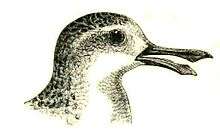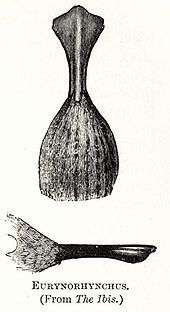Spoon-billed sandpiper
| Spoon-billed sandpiper | |
|---|---|
 | |
| non-breeding | |
 | |
| breeding | |
| Scientific classification | |
| Kingdom: | Animalia |
| Phylum: | Chordata |
| Class: | Aves |
| Order: | Charadriiformes |
| Family: | Scolopacidae |
| Genus: | Calidris |
| Species: | C. pygmeus |
| Binomial name | |
| Calidris pygmaea (Linnaeus, 1758) | |
| Synonyms | |
| |
The spoon-billed sandpiper (Calidris pygmaea) is a small wader which breeds in north-eastern Russia and winters in Southeast Asia.
Taxonomy and systematics
This species was first described by Linnaeus in his Systema Naturae in 1758 as Platalea pygmea.[2] It was later moved to Eurynorhynchus[3] by Sven Nilsson in 1821.[4] It is now classified under the calidrid sandpipers.[1][5][6]
Description

The most distinctive feature of this species is its spatulate bill. The breeding adult bird is 14–16 cm in length, and has a red-brown head, neck and breast with dark brown streaks. It has blackish upperparts with buff and pale rufous fringing. Non-breeding adults lack the reddish colouration, but have pale brownish-grey upperparts with whitish fringing to the wing-coverts. The underparts are white and the legs are black.[5]

The measurements are; wing 98–106 mm, bill 19–24 mm, bill tip breadth 10–12 mm, tarsus 19–22 mm and tail 37–39 mm.[7]
The contact calls of the spoon-billed sandpiper include a quiet preep or a shrill wheer. The song, given during display, is an intermittent buzzing and descending trill preer-prr-prr. The display flight of the male includes brief hovers, circling and rapid diving while singing.
Distribution and habitat
The spoon-billed sandpiper's breeding habitat is sea coasts and adjacent hinterland on the Chukchi Peninsula and southwards along the isthmus of the Kamchatka peninsula It migrates down the Pacific coast through Japan, North Korea, South Korea and China, to its main wintering grounds in South and South-East Asia, where it has been recorded from India, Bangladesh, Sri Lanka, Burma, Thailand, Vietnam, the Philippines, Peninsular Malaysia and Singapore.[5]
Feeding
Its feeding style consists of a side-to-side movement of the bill as the bird walks forward with its head down. This species nests in June–July on coastal areas in the tundra, choosing locations with grass close to freshwater pools.[7]
Status
This bird is critically endangered, with a current population of fewer than 2500 – probably fewer than 1000 – mature individuals.[8] The main threats to its survival are habitat loss on its breeding grounds and loss of tidal flats through its migratory and wintering range. The important staging area at Saemangeum, South Korea, has already been partially reclaimed, and the remaining wetlands are under serious threat of reclamation in the near future.[5] Long-term remote sensing studies have shown that up to 65% of key spoon-billed sandpiper habitat in China, South Korea and North Korea has been destroyed by reclamation.[9][10] A 2010 study suggests that hunting in Burma by traditional bird trappers is a primary cause of the decline.[11]
Protected areas in its staging and wintering areas include Yancheng in China, Mai Po Marshes in Hong Kong and Point Calimere and Chilka lake in India,.[5][12]
Formerly classified as an Endangered species by the IUCN,[1] recent research shows that its numbers are decreasing more and more rapidly and that it is on the verge of extinction. It is consequently reclassified to Critically Endangered status in 2008.[1][5][13] The population was estimated at only 120–200 pairs in 2009–2010, perhaps indicating an 88% decline since 2002 equating to an annual rate of decline of 26%. Draining of the Saemangeum estuary in South Korea removed an important migration staging point, and hunting on the important wintering grounds in Burma has emerged as a serious threat. This species may become extinct in 10–20 years.[14]
In November 2011, thirteen spoon-billed sandpipers arrived at the Wildfowl and Wetlands Trust (WWT) reserve in Slimbridge, Gloucestershire to start a breeding program. The birds hatched from eggs collected in north-eastern Russian tundra earlier and spent 60 days in Moscow Zoo in quarantine in preparation for the 8,000 km journey.[15] Artificial incubation and captive rearing, termed headstarting, may increase survival rates from less than 25% to over 75%, and the removal of eggs may also lead to a second clutch reared by the parents.[16] In 2013, conservationists hatched twenty chicks in Chukotka.[16]
References
- 1 2 3 4 BirdLife International (2013). "Calidris pygmaea". IUCN Red List of Threatened Species. Version 2013.2. International Union for Conservation of Nature. Retrieved 26 November 2013.
- ↑ Linnaeus, C (1758). Systema naturae per regna tria naturae, secundum classes, ordines, genera, species, cum characteribus, differentiis, synonymis, locis. Tomus I. Editio decima, reformata. (in Latin). Stockholm: Laurentius Salvius. p. 140.
P. corpore supra fusco, subtus albo.
- ↑ From Ancient Greek εὐρύνειν "to widen" + ῥύγχος "muzzle".
- ↑ Nilsson, S (1758). Ornithologica Suecica volume II (1). p. 29.
- 1 2 3 4 5 6 BirdLife International (BLI) (2008a). Spoon-billed Sandpiper Species Factsheet. Retrieved 24 May 2008.
- ↑ Thomas, Gavin H.; Wills, Matthew A.; Székely, Tamás (2004). "A supertree approach to shorebird phylogeny". BMC Evolutionary Biology. 4: 28. doi:10.1186/1471-2148-4-28. PMC 515296
 . PMID 15329156.
. PMID 15329156. - 1 2 Hayman, Peter; Marchant, John & Prater, Tony (1986). Shorebirds: an identification guide to the waders of the world. Houghton Mifflin, Boston. ISBN 0-395-60237-8
- ↑ "Unique wader faces extinction". BirdLife International. Retrieved 2008-03-06.
- ↑ Murray N. J., Clemens R. S., Phinn S. R., Possingham H. P. & Fuller R. A. (2014). Tracking the rapid loss of tidal wetlands in the Yellow Sea. Frontiers in Ecology and the Environment 12, 267-72. doi: 10.1890/130260
- ↑ MacKinnon, J.; Verkuil, Y.I.; Murray, N.J. (2012), IUCN situation analysis on East and Southeast Asian intertidal habitats, with particular reference to the Yellow Sea (including the Bohai Sea), Occasional Paper of the IUCN Species Survival Commission No. 47, Gland, Switzerland and Cambridge, UK: IUCN, p. 70, ISBN 9782831712550
- ↑ Zöckler, C.; Htin Hla, T.; Clark, N.; Syroechkovskiy, E.; Yakushev, N.; Daengphayon, S. & Robinson, R. (2010). "Hunting in Myanmar is probably the main cause of the decline of the Spoon-billed Sandpiper Calidris pygmeus" (PDF). Wader Study Group Bull. 117 (1): 1–8.
- ↑ Sharma, Arunayan (2003). "First records of Spoon-billed Sandpiper Calidris pygmeus in the Indian Sundarbans delta, West Bengal" (PDF). Forktail. 19: 136–137.
- ↑ BirdLife International (BLI) (2008b). [2008 IUCN Redlist status changes]. Retrieved 23 May 2008.
- ↑ Pitches, Adrian (August 2010). "Spoon-billed Sandpiper on a knife-edge". British Birds. 103: 473–478. The hunting in Burma and extinction prediction reported in BB was based on Wader Study Group Bulletin 117 (2010)
- ↑ Gill, Victoria (14 November 2011). "Endangered spoon-billed sandpipers arrive in UK". BBC Nature. Retrieved 15 November 2011.
- 1 2 "20 Critically endangered spoon-billed sandpiper chicks hatched by scientists". Wildlife Extra. July 2013.
External links
| Wikimedia Commons has media related to Spoon-billed Sandpiper. |
- Video of a displaying male at YouTube
- BBC - Bid to save sandpiper at risk of extinction
- Saving the spoon-billed sandpiper, Chukotka expedition 2011
- Video of chicks at Slimbridge WWT. July 2012. guardian.co.uk
- http://www.saving-spoon-billed-sandpiper.com - The spoon-billed sandpiper conservation breeding programme
- http://www.eaaflyway.net/our-activities/task-forces/spoon-billed-sandpiper/ Spoon-billed sandpiper page at East Asian – Australasian Flyway Partnership
